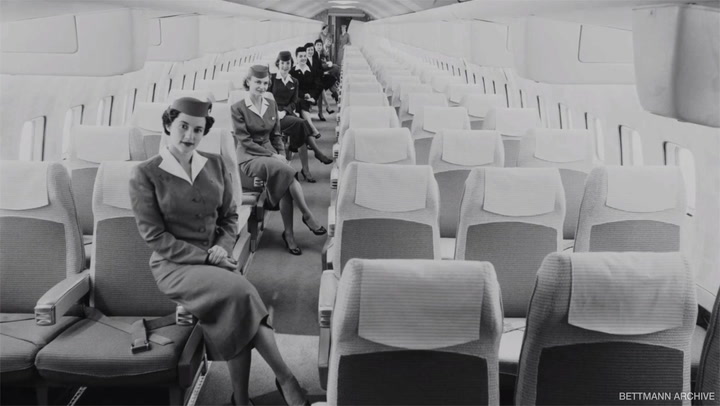The Evolution of Airplane Seats
Airplane seats have changed significantly over the decades, but their evolution isn’t solely due to trends. Understanding the journey of airplane seating reveals a history of comfort, design, and technology.
PJ Wilcynski, Boeing’s associate technical fellow and Payloads chief architect, has witnessed the progress of cabin architecture for over two decades. He delved into Boeing’s historical archives to share exclusive images of aircraft seats from the past.
The aircraft seat had a humble start as little more than a collection of wicker chairs fastened to the floor. By the late 1920s, these wicker chairs were upgraded with leather and padding for improved comfort.
“Leather was very popular because it allowed for easy cleaning due to the soot from early airports and dusty runways,” said Wilcynski.
:max_bytes(150000):strip_icc():format(webp)/1929-Boeing-Model-80-HISTORYAIRSEAT0518-bee07613c3964a6fb14520a05b495218.jpg)
There were improvements in the late 1930s with aluminum-tube seating, thicker seatbelts made of leather, added padding, and velour covers, contributing to a much more comfortable flying experience.
:max_bytes(150000):strip_icc():format(webp)/1934-Boeing-247-HISTORYAIRSEAT0518-ab61a465449e43f9bbe556003268a075.jpg)
:max_bytes(150000):strip_icc():format(webp)/1935-Fokker-Douglas-Dutch-Airlines-HISTORYAIRSEAT0518-2000-c99d496507e8473b90c8e175d3b77569.jpg)
From 1939 to the late 1940s, notable aircraft models like the Boeing 314 Stratoliner and the Douglas DC-3 reflected airlines’ ambition to elevate flying into a luxury travel experience.
:max_bytes(150000):strip_icc():format(webp)/1939-Boeing-307-Stratoliner-HISTORYAIRSEAT0518-b078b3c8d7644f748b04d9aa5711dcaa.jpg)
Seats transformed with many converting to beds for overnight flights, while seatbelt designs evolved from heavy leather straps to buckled fabric belts commonly seen today. Decorative details made the aircraft interiors resemble luxurious living spaces.
Boeing’s 377 Stratocruiser from 1949 was groundbreaking, featuring a spiral staircase leading to a lower deck lounge—offering passengers a space to relax and socialize. Moreover, drop-down beds were available for overnight travelers.
:max_bytes(150000):strip_icc():format(webp)/1949-Boeing-377-HISTORYAIRSEAT0518-a64ddb9e6a1845618d2785b968f61d0c.jpg)
Stratocruiser seats were mounted on shock absorbers to reduce vibration from propellers. Although they may not appear highly advanced, they certainly offered recline options and footrests.
Seats predominantly catered to a single class—those who could afford to fly—until the late 1950s and early 1960s. The introduction of different service classes transformed the landscape of airplane seating options.
“The 1959 Pan Am 707 marked the transition to more diversified seating configurations, with the introduction of tourist class,” noted Wilcynski.
:max_bytes(150000):strip_icc():format(webp)/1956-Boeing-Jet-Stratoliner-HISTORYAIRSEAT0518-f75d59c5cabe443fad328d03993723de.jpg)
:max_bytes(150000):strip_icc():format(webp)/1969-Boeing-747-HISTORYAIRSEAT0518-2bf007bda18747dba8fd1ce4451208dd.jpg)
By 1970, the Boeing 747 introduced nine-abreast seating with a mix of triple, quad, and double rows, although this configuration didn’t last long as airlines shifted towards ten-abreast setups due to fare structure changes. Therefore, legroom decreased, with many airlines adopting tighter seating arrangements.
As a trendsetter, the 747 revolutionized inflight experiences in numerous ways. It was the first to feature enclosed pivoting overhead storage bins, impacting modern aircraft designs.
:max_bytes(150000):strip_icc():format(webp)/1960s-Boeing-727-100-HISTORYAIRSEAT0518-1616996e49d74d45bc7b48c47e8b5ca3.jpg)
:max_bytes(150000):strip_icc():format(webp)/1970s-Boeing-747-Upper-Cabin-HISTORYAIRSEAT0518-85a9f135628c433a930f4c87993635e8.jpg)
The 747 also featured an upper lounge for business class passengers, enhancing the luxury flight experience. This upgrade echoed the lower lounge concept introduced in earlier aircraft models.
In the 1980s, significant advancements emerged that elevated safety and design standards for airline seats. New regulations mandated seats withstand high impact forces while incorporating fire-retardant materials.
Modern luxury business and first-class seating options reflect these innovative changes, transitioning from basic recliner-style seating to sophisticated beds and private suites that emphasize comfort and privacy.
:max_bytes(150000):strip_icc():format(webp)/Boeing-787-10-business2-NEWBOE0318-471a935aa013441d9a02c7f2ca832db0.jpg)
:max_bytes(150000):strip_icc():format(webp)/economy-seating-airspace-cabin-A320-neo-cabin-NEO0617-2d49b49b9f1044218b89019a31886358.jpg)
In economy class, recent advancements include in-flight entertainment systems mounted to seat backs, power outlets for devices, and upgraded tray tables to accommodate electronic devices, significantly enhancing passenger experience.
Designers continue to innovate, and Boeing is currently producing the next generation of aircraft—the 777X—which promises to usher in a new era of flying. Although details remain under wraps, there’s no doubt that the future of airplane seating will not return to the humble wicker of the past.




